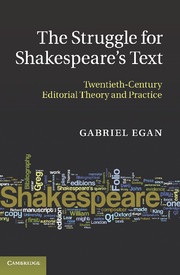Book contents
- Frontmatter
- Contents
- Preface
- Acknowledgements
- A note on references, quotations, names and pronouns
- Introduction
- 1 The fall of pessimism and the rise of New Bibliography, 1902–1942
- 2 New techniques and the Virginian School: New Bibliography 1939–1968
- 3 New Bibliography 1969–1979
- Intermezzo: the rise and fall of the theory of memorial reconstruction
- 4 New Bibliography critiqued and revised, 1980–1990
- 5 The ‘new’ New Bibliography: the Oxford Complete Works, 1978–1989
- 6 Materialism, unediting and version-editing, 1990–1999
- Conclusion: the twenty-first century
- Appendix 1 How early modern books were made: a brief guide
- Appendix 2 Table of Shakespeare editions up to 1623
- Appendix 3 Editorial principles of the major twentieth-century Shakespeare editions
- Works cited
- Index
2 - New techniques and the Virginian School: New Bibliography 1939–1968
Published online by Cambridge University Press: 06 December 2010
- Frontmatter
- Contents
- Preface
- Acknowledgements
- A note on references, quotations, names and pronouns
- Introduction
- 1 The fall of pessimism and the rise of New Bibliography, 1902–1942
- 2 New techniques and the Virginian School: New Bibliography 1939–1968
- 3 New Bibliography 1969–1979
- Intermezzo: the rise and fall of the theory of memorial reconstruction
- 4 New Bibliography critiqued and revised, 1980–1990
- 5 The ‘new’ New Bibliography: the Oxford Complete Works, 1978–1989
- 6 Materialism, unediting and version-editing, 1990–1999
- Conclusion: the twenty-first century
- Appendix 1 How early modern books were made: a brief guide
- Appendix 2 Table of Shakespeare editions up to 1623
- Appendix 3 Editorial principles of the major twentieth-century Shakespeare editions
- Works cited
- Index
Summary
The American advances in New Bibliography became widely known with the launch in 1948 of the journal Studies in Bibliography by the Bibliographical Society of the University of Virginia, under Fredson Bowers's editorship. Emerging differences of opinion about the reliability of the methods of New Bibliography were counterbalanced by the development of ever more technical means for the analysis of early books, such as investigations of compositors' spelling preferences and the evidence that running titles offer about the order in which formes were machined by the printing press. One might say that post-war confidence about the fruits of new technical developments overcame qualms about the school's foundational principles. The new procedures seemed to offer the clearest glimpse yet of the characteristics of the manuscript copy underlying early editions.
Most excitingly of all, analysis of press variants was dramatically sped up by Charlton Hinman's invention of a collating machine, which he applied to the seventy-nine exemplars of the 1623 Folio held in the Folger Shakespeare Library in Washington DC in the hope of speaking definitively about that edition's proofreading and press correction. Together with Hinman's innovative analyses of the frequency of reuse of particular pieces of type (identified by their defects) that revealed the order in which the Folio's pages were set, and the corroborating evidence provided by George Walton Williams's analyses of substitutions forced upon compositors by type shortage, the new discipline seemed to be finding a solid empirical foundation.
- Type
- Chapter
- Information
- The Struggle for Shakespeare's TextTwentieth-Century Editorial Theory and Practice, pp. 38 - 80Publisher: Cambridge University PressPrint publication year: 2010

